Bull
Saturday, December 9th, 2006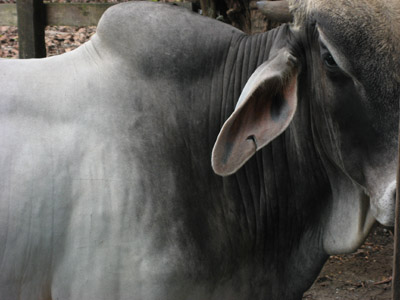
Puerto Jiménez, Costa Rica

Puerto Jiménez, Costa Rica

Trying to show off our fishing prowess, but we actually only caught 5 fish in Costa Rica. 4 dorado and one big eyed jack. All were tasty and it at least made the $24 fishing license worth while. When we asked around in El Coco for the INCOPESCA office to get a license everyone laughed at us and said we didn’t need no permiso de pesca. We tracked them down and bought one anyway because they weren’t too expensive and we hope they use the money to perserve their fisheries.
We arrived the other day after a very mild trip around the Oso peninsula (our books says the area is “famous for its violent thunderstorms”). We had probably four knots of wind all night, then upon sunrise, it poured rain. I stood in the cockpit on watch under the umbrella while the boat just sat still in the middle of the gulf, the water pounded flat.
According to Charlie’s Charts, there is one anchorage between Parque Manuel Antonio and Bahia Drake; it breaks the trip up into two nice day-long sails. We set out for Bahia Uvita under light wind and arrived about an hour to sunset with a storm about to dump on us and our wind about to die. Our charts show Uvita as a hammer-shaped lump at the end of the spit of land, thereby creating a little protected nook to anchor; Charlie’s doesn’t show the hammer but it has a little island and says that the exposed reef cuts the swell to create a mellow spot to anchor. In actuality, a storm at some point must have wiped out all land lumps and islands because now there exists only a blunt nub of land with a mile-long exposed reef sticking off the end. The swell comes over this and breaks up into billions of choppy wavelets that create a high-frequency barrage of wakes, thereby turning the anchorage into a godawful mayhem. We discovered this around the time the wind died, the sun set, and the rain started; so we stayed.
It was a rolly, lurchy, violent night and neither of us got the Beauty Sleep; by four or so the next morning, we climbed out of bed and staggered around the boat getting coffee started and trying to get the motor started. Naturally, the motor refused to start and managed only a choking cough sound every time its cord was pulled. We gave up on it and just pulled up the anchor under sail. With maybe two or three knots of wind and the frightful chop generated off the reef, “sailing†out of the anchorage was a vexing experience. We physically held the sails out to keep them from flogging and to try to hang onto what little air there was. At four in the morning we did this. An hour later, we were only 1/2 mile from where we started but we were just far enough around the reef so that we were fully exposed to the open swell; here, thankfully, it was calm enough for Joshua to take the carburetor apart without fear of falling overboard. By hour two, we were still within a mile of the anchorage (lame!) but the wind began to pick up (sweet!). Joshua, who is a fucking genius, actually got the motor running after whatever it was he did to the carburetor and we ran it for a while to give ourselves the impression of forward progress and until we were well out of the reef area. Then we killed it to sail under wind power.
The sail to Bahia Drake actually turned out to be excellent after the rocky start; the wind picked up steadily until late afternoon when it peaked at around 15 knots (perfect wind for a beat) and we were flying through the relatively calm seas. We found a promising-looking scum line (yes, excitement abounds upon the Time Machine) and sailed along it for several miles while trailing delicious plastic squids through the water; sadly, the dorado shunned our lures and our dinner that night was not to consist of the Fish of Opportunity. (Actually, we did snag one skipjack but threw it back because that’s the only one I don’t like.) At sunset we entered Bahia Drake and anchored. The bay is lined with beautiful jungle hills, few scattered houses, no mega time-share high rises, reddish sand beaches, and several river estuaries. There were only a few fishing pangas and one other sailboat in the anchorage. The hills glowed amber and glass windows reflected gold in the setting sunlight.
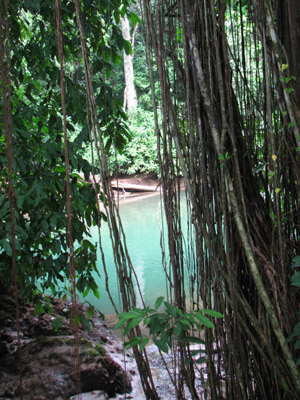
Bahia Drake turned out to be just as gorgeous by day as it seemed the night before. It is remote—the only way to get there often is by boat (yes, we rock) because the rainy-season creates some appalling jeep-swallowing ruts. It also is at the northern edge of the Corcovado National Park, which encompasses a large portion of the Osa peninsula and is one of the largest, most primeval, oldest, tallest, with the most abundant and unique flora and fauna, and a-few-other-things-else-est park in the entire world (if you believe everything you read). There is a small town with a medical compound complete with scrub-bedecked nurses prowling the local ‘sodas’ during the lunch hour and a few “eco-resorts,†which are schmancey hotels nestled amongst the jungle foliage rather than high-rising out of a cleared portion of it, with bars and restaurants and artful landscaping all around everything–and they also cost a bloody fortune. Eco-resorts are invariably owned and run by gringos. There is a trail running down the southern edge of the bay down the coast goes all the way around to Puerto Jimenez, but we followed it only until Bahia Pariaso, maybe six miles away. Along the way you keep feeling like you have left it all behind and I-hope-we-brought-enough-power-bars, but then another kilometer down, you stumble into a clearing where there is a tent camp and a running generator or something (you can hike all over the peninsula, tent camp to tent camp); this time of the year sees few tourists since it is still officially rainy season. We initially worried that we had set off on the hike without enough water but this turned out to be stupid because there were coconuts all over the place and those eco-tent-resort things every few kilometers. Periodically, we would collect a couple of coconuts and bash them open on the rocks (not easy) for the water inside, then continue down the trail munching on the nutmeat. (By the way, coconut husk juice splatters widely and stains badly.) (Oh, also, never eat too much fresh coconut meat because it, um, makes one’s intestinal tract slickery, if you catch my drift.)

The third day, we had planned a leisurely kayak up one of the rivers at high tide, but when lowering the kayak into the water, the Cordura casing ripped and so, until we fix it, that is the end of the kayak. The wind started blowing so we just put our stuff away and took off for Golfito, located around the tip of the Osa peninsula inside the gulf. Mom was due to arrive in a few days anyway so it probably was best we had a chance to scope out the scene and stock up on martini ingredients.
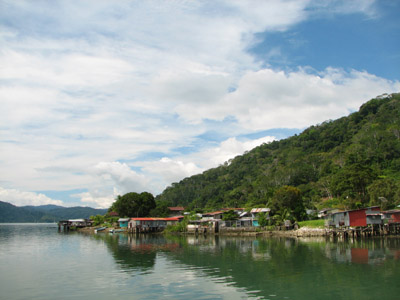
The run to Golfito was an overnight run for us; we wanted to give ourselves a lot of time in case the wind was light and we made poor time. Typically I prefer the second and fourth watches. I dislike the first watch because, although I am infrequently tired right at 6 or 7pm, I fear the initial onset of darkness when we are sailing along into the night with all those night preparations and putting away of things and all that. I like to just try to go to bed immediately and forget about it all. Waking up at midnight for a three-hour watch seems less freakish to me. Jeff always called this the ‘Dog Watch.’ You just get up and it is already dark and you are disoriented because you just were woken up after getting very little fitful sleep but you go above after donning what you assume must be the appropriate clothing and look around and assess the situation, take over the steering wheel and resume. If I am lucky, there aren’t any squalls, I don’t have to do any extensive sail readjusting, don’t have to start the motor (and wake up Joshua because our motor is being lame lately and I don’t have the explosive strength in my arms to pull-start the bastard), and don’t fall asleep. About half the time this is true and I get through the watch without checking the clock on the GPS too many times and then I get to go back to sleep. I know I am really tired when I have a hard time keeping our course straight. Once back in the bunk and a groggy Joshua deposited back into the cockpit, I dream all sorts of confused weirdness; then I get woken three or four minutes later by a very tired Joshua. In reality, three hours have again passed and by now it is the morning shift. Joshua summons the last of his strength to report every light that has passed and how well he could see it and how our course has changed a whole 15 degrees because actually this is the most exciting thing that has happened all night and then he goes below and passes out cold. And I am again sitting in the cockpit blinking my eyes and wondering if there might be any cookies left.
Dawn happens about sixty billion hours later and this particular dawn, on that very uneventful night around Matapalo towards Golfito, the sun rose over heavily cloudy and obscured skies; then it rained. Very hard. I saw it coming and buttoned up the boat tight; then I popped open the umbrella and stood in our cockpit beneath the downpour, listening to the roar. The wind had died utterly and the water was mashed flat by the force of the raindrops but I just stood and waited another hour until Joshua woke up to get the motor started for the last mile into Golfito bay.

In spite of, or probably because of, Margo’s (a.k.a. Mrs. Charlie’s Charts) less than ecstatic review of the Parque Nacional Manuel Antonio (i.e., gobs of people and she only saw white faced monkeys, wah!), we were terribly excited to arrive and get our anchor down. We were promptly rewarded with goodies too; the anchorage is right in the park, right off the prettiest beach, right in the lee of the spectacular “Punta Catedral,†and within clean earshot of the howler monkeys. There was also one funky odor that was a combination between mushroom and skunk. The entire park smelled like it and that first night had me following my nose all over the boat, sniffing at our “clean†laundry, at the dishtowel, at the pile of foul weather gear stacked on the bunk, at the bunk itself until I was mostly convinced the smell did not originate on the Time Machine.
We hopped in the water and swam to the beach to check out the late afternoon scene. People were set up with towels and swimming all up and down the beach (a fair amount of people, but not enough to be horrible). We wandered across the narrow jungly land spit over to the other side, where there was another lovely beach littered with tourists. Then the ranger started blowing his whistle: 4pm, the park is now closed! He herded people out with his whistle and we walked back to the other side to swim back out to the boat. Halfway out Joshua looked back to see one of the rangers standing on the edge of the sand looking after us, shrugging his shoulders to say “what the hell?†Ha ha! Safe back on the boat, we hung out and made micheladas with the last of our beer. We noticed that there was a crowd of mixed gringos and ticos (Costa Ricans) left on the beach, screaming and swimming and generally having a dandy time; the rangers totally ignored them and they stayed long after all the tourists left. After a while some of them swam out to the boat to see what was up with us. They were all volunteers, mostly young people from the UK, and Costa Rican guides; they all lived in a house inside the park. “Oh the park is gorgeous! You’ll love it! TONS of wildlife!†they said. I was stoked. Then we found out that the next day (Monday)–the day we thought we’d be heading in to do all that national park stuff–it would in fact be closed. Damn!
Ah well. Maybe we’d head into Quepos and restock our beer supply. However, the next morning we awoke to a downpour. Around noon when it finally did clear up, it was dreary and still. Since we were not feeling like motoring all the way around the point to town, we decided to spend the day toodling around in the kayak, since we could not go IN the park, we could just sort of go around it. We kayaked around the opposite inlet to an inlet two headlands away where we thought, from the chart, it might be possible to anchor. (After looking at it, it turned out that no, not good—rocky and not as protected as one might think, but fun for a kayak.) We actually saw a number of monkeys from the boat too: white-faced monkeys, which look startlingly like cats from a distance (and when you are nearsighted), and squirrel monkeys (which look like squirrels even to a person with 20/20 vision). We got quite a good look at the squirrel monkeys, the first couple we saw and got all excited about turned out to be the first of a large group and they spent a lot of time running up and down the branches of bushes and making huge leaps from tree to tree. These monkeys are tiny and adorable and very lithe. Joshua tried to record the leaps with the video function of our camera but captured mostly the insane lurching of the kayak.
The next morning we tied the kayak up under what we hoped was not the poisonous tree on the beach and walked back to the entrance where we could pay for some tickets (good little bunnies). Then we set out to spot some wildlife. Turns out it is not all that difficult, particularly where guides and tourists are abundant; you just look in the same direction all the other people are looking and you will be rewarded with an iguana, or monkey, or jesus lizard. By the end of the day we had seen nearly every animal we had heard mention of and had taken one and a half gigs of photos and video.
I was pretty jazzed about the squirrel monkeys the previous day but we have seen by now a lot of howlers and so monkeys were not exactly high on my list of must-sees. What were: SLOTHS. I was hell bent on spotting a sloth. A three toed sloth (were there others? Two-toed? Five-toed?). Whenever we passed a particularly excited group of people snapping photos at the underbrush, we’d eavesdrop to discover that alas, it was another lizard or something. After a while we were just hiking around the trails and we ran across a pair of Dutch tourists looking up. “Three-toed sloth,†they said. All right!
Except, I couldn’t see it. I did see a sort of funky growth on the tree. “Is it moving?†we asked. Well, they said, they thought they had seen it move maybe a few centimeters. If I knew anything at all about a sloth, it was not to expect aerobics. Then it did move. It very slowly and deliberately walked along a branch and up another branch; it was like watching a slow-motion film. Then it froze again and munched on some leaves. And it was cute! Sloths look like the Swedish Chef from the old Muppet Show. We watched her (she was a she, we later decided) so long that I had to hold my hand behind my neck so my head didn’t drop off backwards, then we finally moved on.
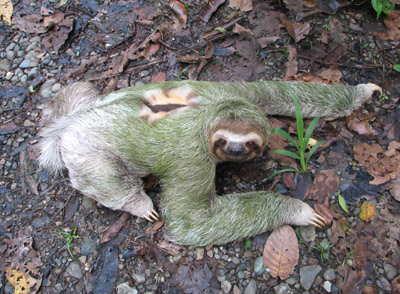
By the end of the day I had completely satisfied my sloth-sighting quota because after a while we got our sloth-eyes on and had to but look up into the forest canopy and there one would be, dangling under a branch. By far the most amazing sloth encounter, however, was when we were walking down a dirt road on the edge of the park. I heard a rustle at the side of the road and a sloth all but tumbled down the embankment onto the road. Right in front of me! We had earlier overheard a guide explain that sloths are very easy to sex—the males have a black dot on their backs and the females don’t; this was obviously a male. “Black dot†is something of an understatement too: this thing is five inches long and looks like an evil eye; the fur is also a different texture and length. Anyway, this sloth just plopped down onto the road, looked up at us, then continued on across the road, utterly unconcerned by me or by any potential traffic there may be. What kind of self-preservation is that? And, while they may move slowly through the trees, they definitely move with finesse; on the ground is another story entirely. He lurched and tummy crawled with his long arms and short legs and those freaky curved claws across the gravel. We self-importantly escorted him across, Joshua shooting photos the entire time. Every so often, he’d swing his head over without breaking stride and give us a mild look. Finally when we got to the other side, he pulled himself up the first vertical thing available and was back in the trees.
I find it difficult to believe, but more than one guide told us that sloths come down out of the trees to go to the bathroom. They climb down, dig a hole, poop (slowly), then go back into the trees. During this time they are of course a sitting sloth for any predators, and they have all sorts of natural predators too: jaguars and other wild cats, big snakes, dogs, taxicabs, etc. I would think that tree-poopers would have been selected for by now so whatever purpose an energy-taxing and life-threatening ground-poop fulfils must be of utmost evolutionary importance.
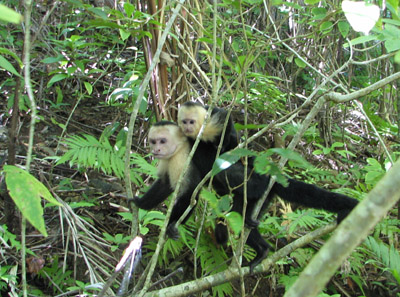
We didn’t see the squirrel monkeys again this day but we did see a large group of white-faced monkeys. These guys are a real crowd-pleaser; they come blitzing through en masse and they are ornery, snatch things from the tourists and each other, run up and down the trees picking at twigs and chewing on leaves, and from time to time, screech loudly and make everyone jump. We chatted with one of the guides while we waited out a white-faced monkey squall and he said that they were the most destructive of all the animals in the park; they tear stuff up, they harass the other slower animals (sloths), and they can get aggressive when stupid humans feed them snacks.

We watched one monkey find a thin brown vine snake, then bite into the middle of it, tearing off strips of meat. He ate only a few bites and then tossed the flailing snake aside (no regard for the starving monkeys over in India). The snake was alive but probably not for long. It was a pretty and very delicate little snake.
We also saw howler monkeys, TWO-toed sloths (sleeping in a tree; these guys are nocturnal and evidently more aggressive than their three-toed Swedish-chef cousins), an abunti (rodent of unusual size), iguanas, jesus lizards (those guys that run on water, like in Wild Kingdom), long-nosed bats (roosting in the tops of the poisonous trees), many morphos and other insects, coatis, raccoons, and a family of deer.

[Two-toed sloth; from this photo he looks downright scary.]